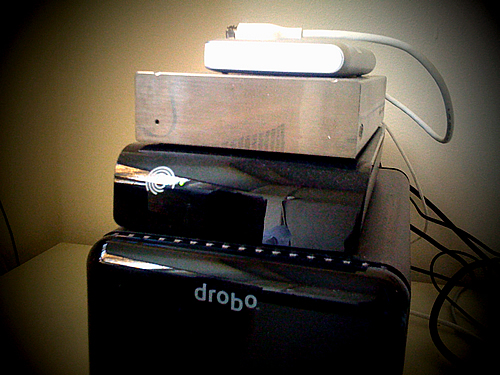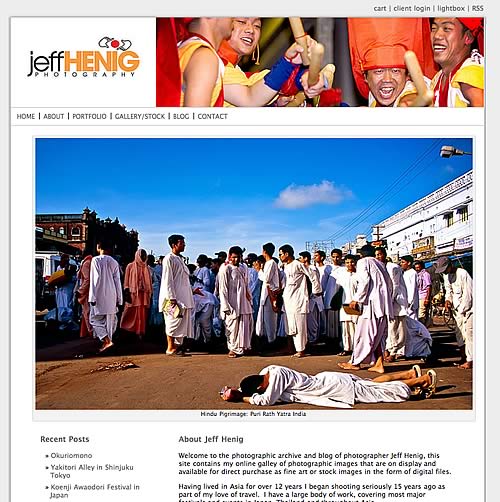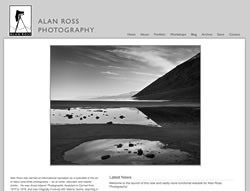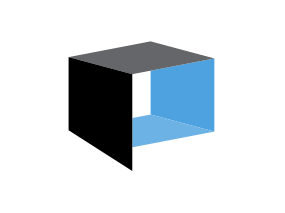
When we shot on film we didn’t have much of a backup strategy. Amateur photographers would get the prints back from the lab, and store the negatives with the prints, the more hardworking of us putting at least some of the prints in albums. We didn’t keep extra copies of the images (except the dupes we’d send to family), and probably didn’t offer much protection beyond some envelopes and a cardboard box.
But now we’re shooting digital we have many more options on how to preserve and protect our valuable files. Here’s my approach, which I use both for client work and for my own projects.
The basic idea is that I never have only one copy of anything, and the multiple copies are in multiple locations. That way I’m protected against drive failure, my own stupidity (deleting files I don’t want to), and physical catastrophe (fire, flood, theft, and the like.
Even though file sizes keep getting bigger, the cost of external storage is so low now – 500GB for $70 or so here in the US – there’s no excuse for not backing up your stuff.
1) Get the image off the card as quickly as possible
In some ways, the most vulnerable time for your images is as soon as you’ve shot them. Memory cards are pretty reliable, but not as dependable as hard drives, and with a very few exceptions, cameras don’t create automatic duplicates of the images on multiple cards. So get them onto a computer as quickly as possible.
2) Backup the images before you do anything else
It’s tempting to start sorting and adjusting the images immediately, but try and get into the habit of creating a backup of the originals before you do anything else.
I use Apple Aperture which has a straightforward backup system using Vaults which makes this easy (I’ll not go into details here, but for those familiar with Aperture, I use managed not referenced Masters, with a number of different libraries for different types of work). However you do it, make sure you’ve got safe copies of your original files.
Even though programs like Aperture and Adobe Lightroom don’t make changes to the original files as you make adjustments, duplicating the originals gives you some peace of mind. This backup should be on a different drive from the first version – having two copies of your images on the same failed drive won’t do you much good.
3) Offsite backup
Keeping your backup drive next to your computer is convenient, but if you’re robbed or the house burns down, then you’ve lost both copies. It can be a pain, but it’s crucial that at least one of your backups is offsite. You could maybe swap drives with a friend for safe keeping.
I keep one of my backup drives in the office, with the other at home (and the main drive containing my libraries travelling with my laptop.)
That way even when I’m working on files and two of the drives are together (at home or at work), there’s always a third in another location.
4) Drobos and RAID arrays
As well as individual hard drives, there are options using mirrored drives, where the same information is automatically written to two drives. Therefore if one drive fails, you can continue working as if it never happened.
A Drobo is an easy to use system that does much the same thing as a traditional RAID 1 array (which can be trickier to use). One of my Vaults is on a Drobo in the office, so the same information is actually stored on four drives (1 main, 1 portable vault, and another vault mirrored on 2 drives on the Drobo).
But you should never have all your information just on a Drobo or RAID 1 array – you’re more protected from disk failure with such a system, but no more protected against someone walking away with the whole device.
5) A note on drives
For photograph and other backups, I’ve used a bunch of drives over the years. And yes, they do fail. The only drives that have failed on me, however, have been ones from LaCie. Maybe that’s just coincidence.
For external portable drives I mainly use ones from Otherworld Computing. For what’s it worth, when I did my Aperture 2 training course the instructor (who also worked with video a lot, so was storing a ridiculous amount of data) recommended Seagate or Hitachi drives, and didn’t have many good things to say about Western Digital.
6) Online options
As physical disk space has become very cheap, so the options for online storage have increased. Services like Dropbox, JungleDisk or Mozy allow you to store your images in the cloud.
Photography-specific services like Smugmug, Photoshelter (or even a Pro Flickr account) offer safe storage with lots of extra useful features such as web-accessible galleries.
Upload time for lots of files will be slow, and your backup is only safe as long as the company stays in business. For these reasons I wouldn’t use it for my only backup, but it’s a handy belt and braces approach.
7) Backing up finished files
This is something I’m not great at. One of the joys of using Aperture or Lightroom is that you don’t have multiple files that represent each photograph in different stages of editing. So there’s no fighting your way through nested folders to look for the original file, the square crop, the black and white, the cross-processed one or the lo-res web version. You can have all these versions, but there’s only ever one file, with sets saved in the program’s database with the settings for all the different versions.
That means the finished files don’t really exist until I export and send them to someone. Often I’ll not even keep those files because I figure I already have them in my (super backed-up) library.
But if every Macintosh computer in the world disappeared overnight, taking every copy of Aperture with it, I’d be in trouble (see where your thoughts can end up when you start thinking about backup options). What I should do is output TIFF or high-res JPG versions of all the files I’ve adjusted.
Burning these to DVD (or dumping them on another hard drive) would ensure that I wouldn’t have to recreate all those adjustments that took me so long.
Conclusion
These are by no means the only way to store your stuff safely, and I’m sure there are other things I could and should be doing. But this is my backup strategy, and it’s one that allows me to sleep at night. Not sure what I should do with all the film prints and negs we still have kicking around, though.
If you’ve any comments or suggestions, feel free to share them below.





 I’ve just launched a new site for Santa Fe-based landscape photographer, master printer and teacher Alan Ross.
I’ve just launched a new site for Santa Fe-based landscape photographer, master printer and teacher Alan Ross.
